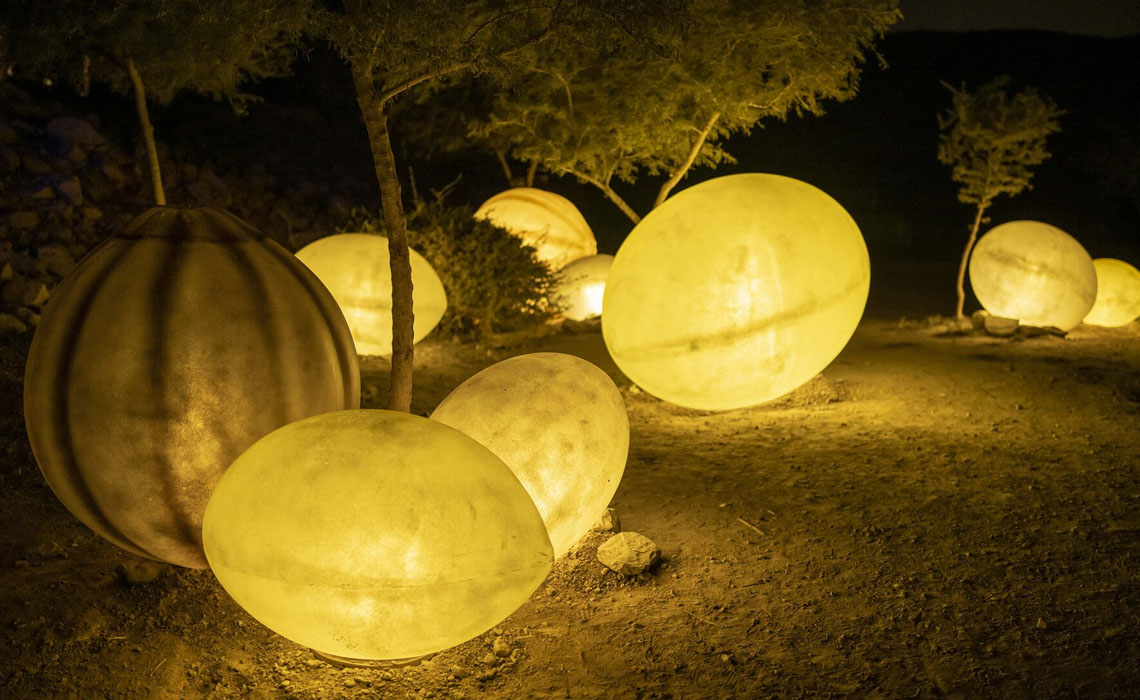As Saudi Arabia’s capital city prepares for the latest edition of Noor Riyadh (opens 30 November), the curators and artists reveal what’s in store for audiences through the dynamic power of illumination.
There’s a certain pleasure in seeing a biennial or other art event outside of its opening days. You see how residents of a city – the audience that the exhibition is ostensibly for on paper, but rarely is – interact with the works. How the art intervenes, or doesn’t, in the urban fabric and the lives of its denizens; how it affects the way they understand both themselves and their city.
The inaugural Noor Riyadh in 2021 was my introduction to the Saudi capital. Although I had transited through before, it was my first time spending any significant time in this sprawling city. When I arrived about two weeks into the festival’s Covid-curtailed run I couldn’t quite make sense of Riyadh, but the event’s 13 locations functioned as both a constellation and an indexical map: here’s the financial district, the tech hub, the glitzy megamall, the lively historical centre, the remarkably conserved birthplace of the Saudi dynasty. When I saw VOUW’s aerial timelapse of Riyadh’s rapid development, growing out from Al Murabba, the city began to fall into place.
The next year, during the closing weekend, I rented a car and drove around the various locations, expanded this time to include much more of the city than its western artery. This festival was three times bigger, featuring 130 artists. It broke six Guinness World Records, including for the largest light art festival, the largest laser show by area covered, and the most drones performing an aerial dance display. It was almost impossible to see everything in the three days I was there. I was frustrated, but I understood that inasmuch as the festival hopes to draw in tourists, like literal moths to a flame, its primary focus is the denizens of Riyadh themselves. I noticed certain works being thoroughly enjoyed by families and children, underlining how Noor Riyadh appeals to all ages.
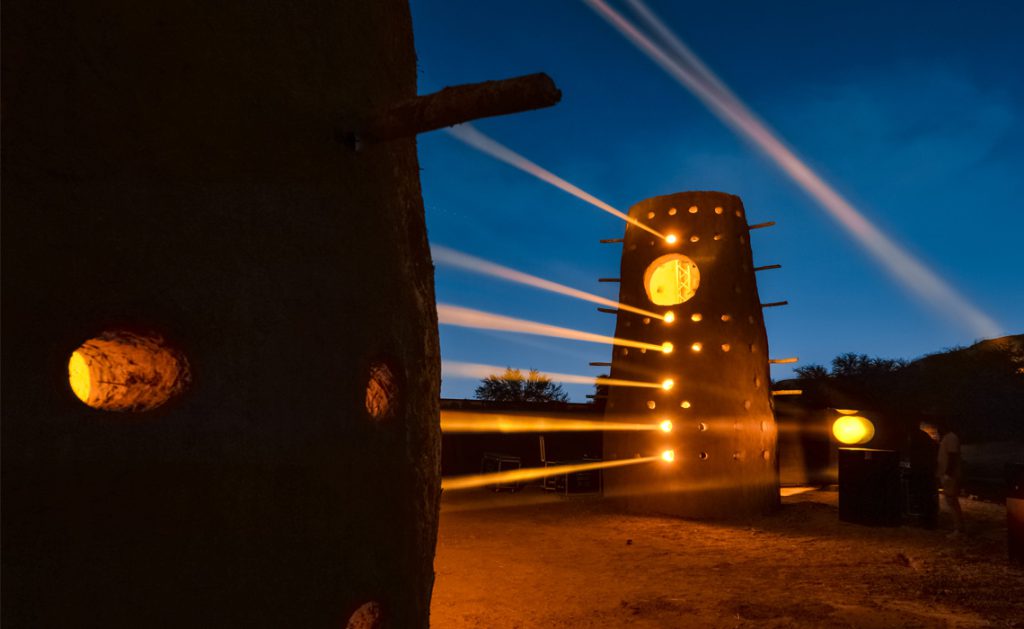
Image courtesy of the artist. © Noor Riyadh 2022, a Riyadh Art programme
There were remarkable moments in the 2022 edition. In there habilitated Wadi Hanifa in the west of Riyadh, light shone outof two adobe dovecotes, with six horizontal rays intimating a musical stave. Instead of pigeons, however, Ahaad Alamoudi’s installation Ghosts of Today and Tomorrow (2022) featured a pair of singers performing mawwals, or sung poetic laments, from the Red Sea coastal plain. Nearby, amongst picnicking families and curlicues of barbeque smoke, Bashaer Hawsawi’s sculptures of sun-dried lemons at various stages of dehydration Early Ripening (2022) invoked the warmth of the absent sun, and Gisela Colón’s One Thousand Galaxies of Light (2022), a constellation of vertical tubes, spanned both sand and lake water like an otherworldly mangrove forest. A few hundred metres away, eerie over some unlit and rather desolate wetlands, was a performance film by Sarah Brahim, installed underneath the high overpass of a major cross-country highway. I found myself especially impressed by the enthusiastic, knowledgeable ushers stationed to explain each artist’s work and how it fitted into their practice.
In a JAX district warehouse meanwhile sat Zahra Bundakji’s The Voice of Listening (2022), a paean to dance floor culture, with multigenerational oral histories from women swirling from speakers arranged around a monumental disco ball. Elsewhere across the city was Muhannad Shono’s truly stunning I see you brightest in the dark (2022), which was deservedly crowned, through word-of-mouth, ‘a must-see festival highlight’. Here, loomlike skeins of illuminated thread moved over four floors of a 1980s house, from basement to rooftop, taking the viewer ona quiet, elegiac journey of memory and loss. It was a beautiful, considered moment of respite that felt like it took seriously what could be done with light beyond just turning on a switch.
Noor Riyadh is an integral component of Riyadh Art which, under the auspices of Vision 2030, aims to integrate art with the city’s urban fabric, including roundabouts, the metro and other transit conduits. This year, ahead of a major highway installation in the capital, German artist Nevin Aladag will wrap three building-connecting bridges with patterns from her Pattern Kinship series, which enmesh various house facades and architectural references from around the world. Remembering her visit to the previous edition, she notes that a festival like Noor Riyadh is especially apt for the city, as “works that deal with light in outdoor places are a great way to turn the evening into day and make it more accessible. Families and visitors etc were all outdoors and the many different places were filled with artworks illuminated to make the evening even lighter.
Saudi artist Dur Kattan similarly points out that Noor Riyadh’s approach “breaks down barriers by making art more accessible and bringing it closer to the community. Rather than confining art to galleries or museums, it is integrated into public spaces.”Spread across the city, the last edition made use of several hubs that allowed people to experience a number of different artists at once and experience something of the festival’s magic without having to spend hours in traffic gridlock. This distribution of works means that for a few weeks every winter the festival lights up every resident’s life, regardless of whether or not they might choose to attend a gallery or institutional exhibition. Its reach extends equally to visitors to the city. I can imagine Noor Riyadh becoming a beloved part of the Saudi capital’s cultural calendar, as much a draw for tourists as the Dyker Heights Christmas Lights in Brooklyn, Chiang Mai’s lantern festival and Lyon’s Fête des Lumières.
More deeply, Noor Riyadh is changing how residents interface with their city. Reflecting on past editions, exhibition co-curator Maya Al Athel is clear about its impact. “This festival has brought about a transformation in the way people perceive and engage with Riyadh, fostering a sense of civic pride and cultural identity,” she affirms. “Residents have developed a deeper connection to their city, seeing it as a vibrant hub of artistic and creative expression.” Al Athel emphasises the festival’s place making nature, particularly “its ability to literally reshape the cityscape. Riyadh is transformed into an illuminated canvas, with architectural landmarks and public spaces becoming part of an enchanting night-time spectacle. This transformation not only adds to the visual appeal of the city, but also creates a unique and immersive experience for residents.”
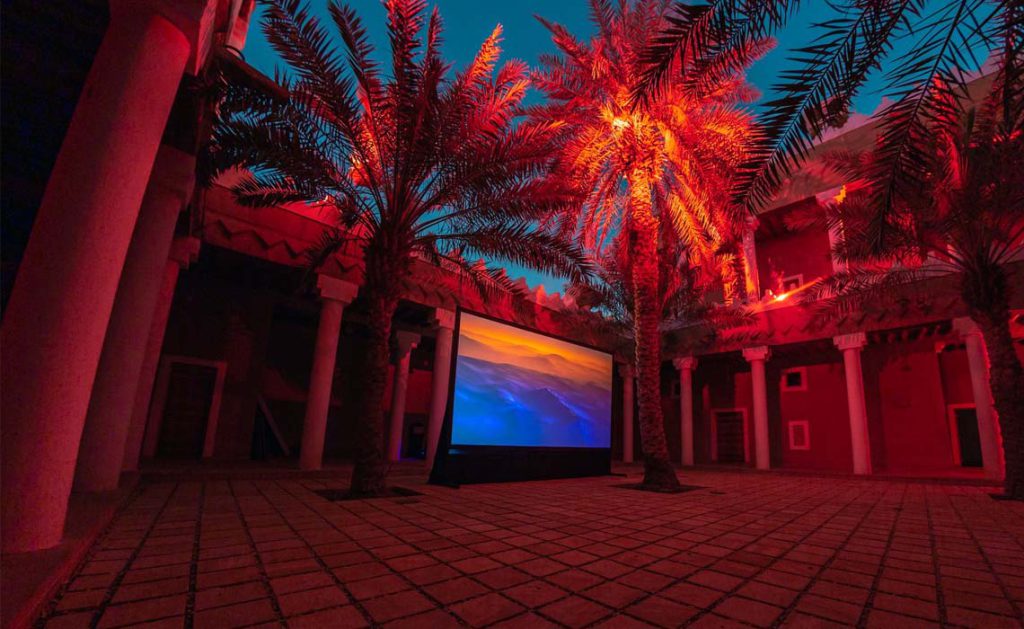
Installation view of Noor Riyadh 2021 at King Abdulaziz Historical Center, Riyadh, 2021. Image courtesy of the artist. © Riyadh Art
Still, one might wonder whether an event like this works to not just reframe the city but also to actively produce an art-going public, bringing work to those for whom traditional spaces like museums or galleries feel neither accessible or relevant. If so, what kind of expectations for an art experience does it create?
Every year, Noor Riyadh is accompanied by an indoor exhibition. The first year was educational, sketching a historical arc of Californian light art and writing Saudi artists into that tradition. The second year was focused on offering an entertaining experience for the estimated 2.7 million visitors that attended the 17-day festival portion of this edition, with the exhibition extended for a multi-month run. More broadly, it worked as an exegesis of a thesis, designed to introduce visitors to a set of art historical or theoretical ideas. The festival, in contrast, most crucially introduces the city to itself.
Alongside the festival and exhibition is an extensive programme of events designed to involve the local community and nurture and develop wider public interest in art. Through talks and discussions, workshops, training sessions, guided tours and activities, as well as apprenticeships and volunteering opportunities, Noor Riyadh is able to reach a wide range of new audiences and create a meaningful legacy for the future.
For 2023 the exhibition will once again be curated by Neville Wakefield, along with Al Athel. Its theme, Refracted Identities, Shared Futures, draws parallels between Riyadh’s desert surrounds and its cultural landscape. As Wakefield explains,“The desert, often perceived as stark and unforgiving, takes on a mesmerising beauty when bathed in the gentle radiance of the sun and moon. In parallel, Riyadh’s urban landscape is a canvas of transformation, reflecting the city’s rapid evolution during this exciting cultural renaissance. Just like the desert that springs to life under celestial illumination, Riyadh’s promise of artistic growth shines brightly.”
Held again this year in the JAX district, the exhibition enriches the Noor Riyadh experience by offering an intimate, immersive counterpoint to the visual spectacle of the festival. Its more in-depth thematic exploration allows for reflection, and for artists to show works that might not be feasible outdoors. “In this sense, it acts as a unifying element that brings together the diverse artistic expressions of the citywide festival,” Wakefield continues.“It allows visitors to digest and reflect upon the interplay of light in both the urban and desert landscapes [and] provides an opportunity to appreciate the spectacle of light in a more concentrated and meaningful way.”
Al Athel adds that they want the exhibition to function asa dedicated hub that allows visitors to reflect on the citywide festival as a whole. “By curating this group exhibition, we aimed to create a show that is not only worth seeing but also serves asa thoughtful and thought-provoking addition to the overall Noor Riyadh experience,” she explains. “The pared-back scale allows for a more nuanced exploration of the festival’s themes, fostering a deeper connection between the artworks and the audience while complementing the grandeur of the citywide installations.”
A highlight will be the world premiere of a work by the pan-European collective Random International, which will extend the collective’s interest in physical – as opposed to virtual or screen-based – interactions with other lifeforms, and the horizon where algorithm meets neurochemistry. Visitors will be invited to interact with an ‘organism’ that will live inside the exhibition for its duration. “How does it feel to immerse yourself in a collective sentience? How do artificial life forms look like, how do they move?” they offer, adding how they think that “it is amazing that we are invited to bring work that plays and experiments with our human relationships with our (algorithmic!) world to a society that is at the forefront of building those futures.”
Kattan’s meditative commission takes car-wing mirror blind spots as a metaphor for our hidden private selves, with illuminated mirrors that refract a fragmented reflection back at the viewer. Like Random International, she similarly emphasises interconnectedness and the relationship between the individual and various collective bodies. Of course, cities have identities too, which are both shaped by and reflected in their art ecology.“I find this message particularly significant in Riyadh,” says Kattan, “where the pursuit of success and the constant drive for achievement can overshadow one’s personal well-being and relationships. Through my work I encourage viewers to slow down, find balance, and take the time to explore their own blindspots. My artwork allows viewers to literally see themselves in the fragmented mirror image of their physical being while encouraging them to reflect on their inner selves.”
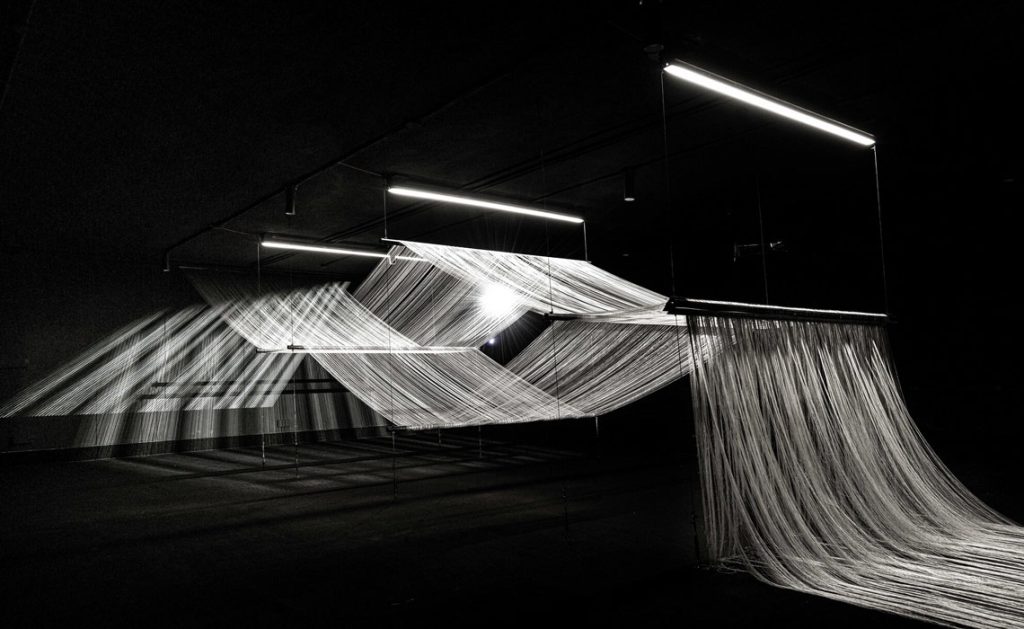
Image courtesy of the artist. © Noor Riyadh 2022, a Riyadh Art programme
Random International also asks us to consider our environments as living organisms rather than just a space we inhabit, and by extension, exploit. Planetary problems and the possibility (necessity) of sustainable cohabitation are condensed to a gently multisensory, interpersonal scale. They are especially excited to be showing in Saudi Arabia. “We know few audiences that are more curious and engaged with the work than those in the Kingdom,”they explain. “The transformation of societies is playing out in real time here, and the future is becoming a visceral quality in Riyadh. We believe that it’s a privilege to be invited to engage with audiences that are living in these transformative times and to share our work with them. We know from Sharjah that the younger generations develop a deep, confident understanding of the ways that work like ours can be experienced and we hope that this will be the case in the Kingdom as well.”
For artists and audiences alike, new vistas are constantly emerging.“I tend to romanticise the horizon,” says Emirati artist Shaikha Al Mazrou. “I’m interested in the crack of the light, where’s that infinite line? Is it something measurable?” For Noor Riyadh, she is making a juxtaposed pair of cast brass sculptures whose patinated gradations suggest landscape painting, with a molten wash between earth and sky. Even as she looks to translate light through colour, her work remains process-based, emphasising the cultural language hidden in the process of metal oxidisation. While many artists attempt to localise their works to the Saudi context, Al Mazrou instead prefers to emphasise the groundless and the unanchored with its sense of silent, limitless possibility.
There’s a universality to the horizon: we all experience it to some degree, albeit often obscured by buildings. We tend to take the horizon as a ready metaphor for a limit – we might travel to broaden our horizons, for example – or equally a boundary, particularly to delineate the near future. We can consider Vision 2030 here as a horizon, along with all of its sister plans in the Gulf, from “We the UAE 2031” to Kuwait’s Vision 2035. Al Mazrou points out that historically the horizon has also been a way finding tool, whether over sand or sea. “The horizon was made as an instrument gaining orientation by using the horizon and the stars,” she says.“It’s people in the middle of a desert, people in a body of water, like sailors. They would navigate through their environment and it becomes not just observation or a vision, but a sense of direction as well.”
This kind of peripatetic heritage directly informs PHI Studio.They relate how, when on the move, “Bedouin people have an interesting practice of drawing a circle in the sand to protect themselves from scorpions and snakes. They also place their walking stick in the same direction they intend to go. This circle and stick serve as tools for protection, preservation and avoiding the pursuit of mirages.” The resulting commission transposes these ancestral practices into a circular installation in which sand and light are made interactive through drawings, like a rather more luminous and graceful Etch-a-Sketch. PHI add that as for the Bedu, their work “creates a sense of safety within the circle and the surrounding ring”.
Noor Riyadh is a supportive and collaborative environment designed to encourage artists to explore their creativity. As PHI note, “The festival has consistently provided a fertile ground for the convergence of intellectual and artistic expressions, showcasing the unique abilities of practitioners within the Saudi art scene. The practices of artists and professionals in the field translate culture through artworks and community activities that accompany each edition, underscoring the significance of the Saudi art scene locally and its positive global presence.”
Kattan adds that “Noor Riyadh is a significant part of the expanding art scene in Saudi Arabia. The festival not only showcases the creativity and talent in the region but also positions Riyadh as a global hub for art and culture. As the festival continues to evolve, it has the potential to shape the future of the art scene in the Kingdom, inspiring new generations of artists and fostering an environment in which art can thrive.”
In past editions, artists have tended to experiment directly with using light as a raw material. This time, however, they are broadly considering light within the context of their existing practices, often as a vehicle of memory. Saudi artist Abdulmohsen Al BinAli, for example, will extend his explorations of world building, dioramas, to create a controlled, immersive environment stop-motion film about an ancient female priestess who sleeps in an oasis and receives prophetic dreams. Archaeology, magic and reverence for nature swirl with multiple points of view that converge and diverge as her dream unfolds. He explains that it“examines the interconnectedness of dreaming and the desert, inviting viewers to delve into their inner landscapes and connect with the rich cultural heritage of ancient Arabia”.
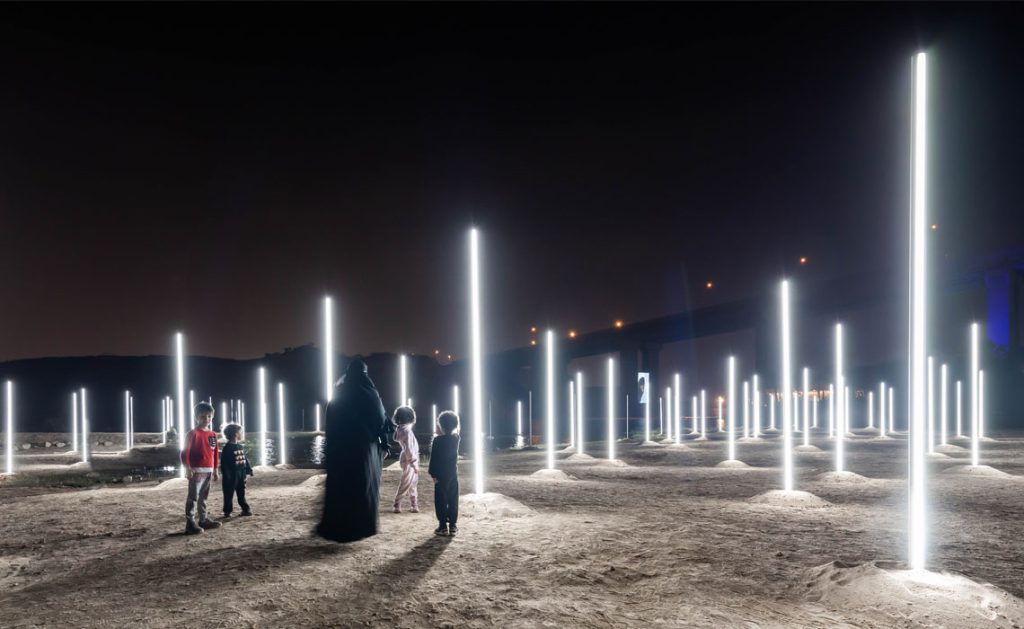
Image courtesy of the artist. © Noor Riyadh 2022, a Riyadh Art programme
Folkloric and collective memory is also central to the work of Bahraini artist Mashael Al Saie. Here, she transposes the alchemical transmutation of a maiden’s body into a body of water– the Bahraini natural spring Ain Adhari, now dry since the 1980s– via a two-channel video that that pours light into 40 frankincense-enclosed glass teardrops that signify the maiden’s pain. “Having heard stories of the spring without personally experiencing its vitality, I attempt to pay homage to the heroine’s transformative tears that birthed the site itself,” the artist explains. “The sculptures are arranged at different heights throughout the space to orient viewers towards a suspended, transcendental moment in time that foreshadows the alchemy of tears transforming into an oasis.”
Here, light – in the form of glassmaking’s white-hot transference of energy – becomes the vehicle of both storytelling and transformation. As with regional history and ecological degradation, the violence of the process is seared away to leave a quiet, beautiful fragility. Other artists like Bashaer Hawsawi consider more recent memory in the form of 1990s fibre-optic lamps that created a Pomeranian’s tail-like splay of pinpricked light, which becomes an installation encouraging viewers to revisit a childhood sense of play. “I can see light in the past, and also it can refer to a new day, an old memory, a joyful perspective, or even a fun idea,” she points out, highlighting the inextricability of light with Saudi society, from the buzz of night-time signage to memories of bedazzled wedding halls.
Meanwhile, Saudi artist Ayman Yossri Daydban considers the region’s cultural heritage as a means to deconstruct Western colonial archetypes about it, and consider new, unadulterated notions of citizenry and identity. His massive chipboard mesh structure suggests an abstracted ghaf tree and casts travelling shadows thrown by the sun during the day and static ones at night.“We can’t know the kind of tree from the shadow,” he explains, adding that “the tree looks like the home, the balad, the country”.
Like many of the international artists taking part in this year’s festival,British artist Conrad Shawcross will be travelling to Saudi Arabia for the first time, despite having shown there before. “I’m extremely excited to experience this fast-evolving country and its culture with my own eyes,” he says. He also sees his work as particularly resonant with the Kingdom. “There’s a lot of psychological potential with the geometries that I use,” he adds. “They’re very in keeping with the cultural sensibilities and sensitivities of the country, the mindset, the ways of seeing. I think that my work has real potency and potential to be seen through those cultural eyes.”
Shawcross is showing a suspended lantern-like work which he describes as essentially a shadow maker, a pair of moving lights inside a concentric series of prismatic mesh cages. “It casts these complex interference patterns across the space that shift and move and evolve,” he explains. “As the cycle of the lights completes its rotation, the whole room becomes influx as a result of the shifting shadows that appear like water moments or crystals or different kinds of geometries. Or the dappled light of the sun. So, it has these different resonances with the viewer.” The piece is part of an ongoing series inspired by scientist Dorothy Hodgkin’s pioneering work on crystal radiography in the 1950s. “She described that process as like trying to work out the structure of a tree by only seeing its shadow,” says the artist. It’s a sentiment that applies to other works and artists in this year’s festival, and indeed to the Saudi art scene as a whole. As the Kingdom continues to open up and reach new horizons, so Noor Riyadh is helping to illuminate the capital city.
This feature first appeared in Canvas 110: It’s Electrifying


